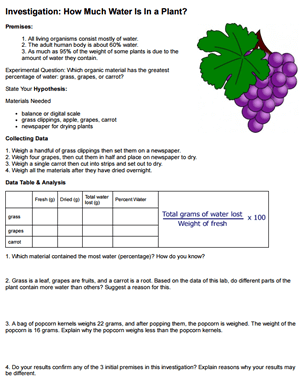
This simple investigation can be used with a lesson on the scientific method. Students compare the amount of water in three types of plants: a root (carrot), a fruit (grape) and a leaf.
Students use a triple beam balance or digital scale to measure the mass of the plants, then dry them overnight and measure the mass again.
They compare their data to the premise that as much as 95% of a plant is water by employing calculations to determine what percent of the original plant was water. Finally a set of analysis questions is used to apply knowledge and propose an explanation for their results.
Grade Level: 7-9 | Time Required: 15 min set-up, 20 min gathering data next day

